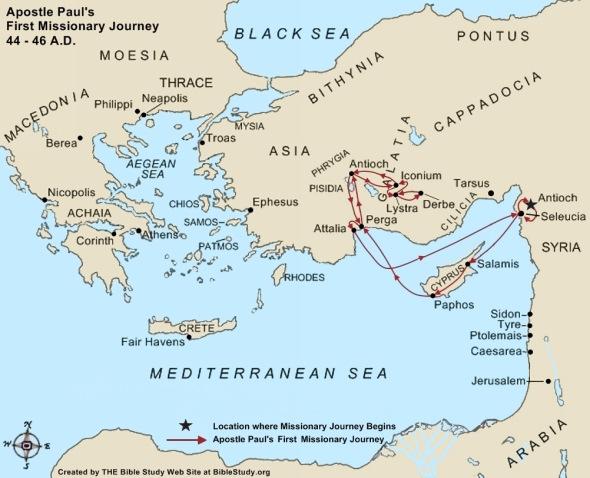Paul’s First Missionary Journey
13:1 to 14:28
Paul is Sha’ul and Sha’ul is Paul
As it turns out, Sha’ul – derived from the famous first king of Isra’el, from the tribe of Benjamin, to which Sha’ul/Paul himself belonged (Philippians 3:5) – is simply the Hebrew name for this person. Paul, is a Greek name derived from the Latin surname Paulus. For someone born in Tarsus (Acts 21:39) but educated under Gamaliel in Yerushalayim (Acts 22:3) in a strict form of Pharisaism (Galatians 1:14; Philippians 3:5-6), this was not unusual. Sha’ul was a Jew of the Diaspora because he came from Tarsus, and Jews of the Diaspora always had two names – a Jewish name (Sha’ul) and a Gentile name (Paul).
Here’s the clincher. When Paul recalls his conversion, he specifically notes that Yeshua was speaking in Aramaic, the common Hebrew language of the day: Sha’ul, Sha’ul, why are you persecuting Me (Acts 26:14)? Paul draws attention to how Messiah addressed him by his Hebrew name, and makes no mention that it is now abandoned.
When Sha’ul/Paul launched his Gentile-focused ministry among Greek-speakers (beginning with Acts 13:9), it was natural for Luke, the author of Acts, to begin referring to him exclusively by his Greek name. Nor is it surprising that he’s later referred to as Paul in Jerusalem, since there were Greek speakers there also. Indeed, Luke could be making a thematic point by shifting from Sha’ul to Paul around Chapter 13, given the broader theme in the book of Acts as seen in 1:8: But you will receive power when the Holy Spirit comes on you; and you will be My witnesses in Jerusalem, and in all Judea and Samaria, and to the ends of the earth. After all, there was a shift going on from the beginnings of the Messianic Community in Jerusalem, to the Goyim at the ends of the earth and the Roman Empire.
Sha’ul/Paul’s two names were not unique. Several other people in the B’rit Chadashah were given two names: Joseph, later called Barnabas (Acts 4:36); Simeon, also called Niger (Acts 13:1), Thomas, also called Didymus (John 21:2); and Tabitha, was also called Dorcas (Acts 9:36), and Nakdimon (his Jewish name) was also known as Nicodemus (John 3:1-21), among others.271
First Missionary Journey:
44-48 AD
Luke’s data for this period is clearly sketchy,
He is better informed about the period after the Jerusalem counsel.
Paul wrote Galatians (about salvation), part of the Big Four (see Ad – Letters of Paul), from Syrian Antioch in 48 AD. When he wrote the letter to the Galatians, Galatia was divided into two regions. The principal cities of the northern region were Ancyra, Pessinus, and Tavium. The cities of the south included Pisidian Antioch, Iconium, Lystra, and Derbe. Paul’s letter was probably addressed to the four southern churches, the ones he visited on his First Missionary Journey.
Chapter 13 marks a turning point in the book of Acts. The first twelve chapters have focused on the ministry of Peter; the remaining chapters focus on Paul. Until now the emphasis has been on the Messianic community in Jerusalem and Judea; Chapters 13-28 describe the spread of the Gentile Church throughout the Roman world. And it was from the dynamic, doctrinally sound, growing, Spirit-controlled church in Syrian Antioch that the flag of Gentile missions was unfurled. It had spiritual leaders, with a spiritual ministry, who went on a spiritual mission, faced spiritual opposition, and experienced spiritual victory.272
The Ruach ha-Kodesh was very strategic in His leading of Paul on his First Missionary Journey. Paul and Barnabas first went to Syrian Antioch and they were warmly received. It was a dynamic church, and would turn out to be the base of Gentile evangelism. The first missionary journey began with the appointment of Barnabas and Paul from the church at Syrian Antioch. In each leg of their journey they experienced increased hostility.
The second leg of their journey was Pisidian Antioch. As would be his practice, Paul first went to a Jewish synagogue to preach the gospel. But he was rejected, so he said: It was necessary for the word of God to be spoken to you first (Romans 1:16). But since you reject it and judge yourselves unfit for eternal life – behold, we turn to the Gentiles (13:44-46). This would turn out to be the pattern of evangelism in the book of Acts. But the Jewish leaders stirred up persecution against Paul and Barnabas, and they drove them out of their district. So Paul and Barnabas shook the dust off their feet against them, and they went on to Iconium (13:50b-51).
Next they went to Iconium and the pattern of resistance increased from merely driving them out of their district to both Jews and Gentiles attempting to stone them. Now it happened that both the Gentiles and Jewish people, along with their rulers, made an attempt to abuse and stone them (14:5).
Lastly, Paul and Barnabas traveled to Lystra: There, new methods of evangelism were needed because they were trying to reach pagan Gentiles with no Jewish background. But not surprisingly, the pattern of resistance increased. We now see that the Jewish opposition to Paul and the gospel was more organized. But Judaizers came from Pisidian Antioch and Iconium (see the commentary on Galatians, to see link click Ag – Who Were the Judaizers?) . The Jews traveled about 100 miles to oppose Paul and Barnabas’ ministry in Lystra. The stoning which had been plotted in Iconium (14:5), now took place. And after they won the crowd over they stoned Paul and dragged him out of the city, supposing him to be dead (14:19).




Leave A Comment